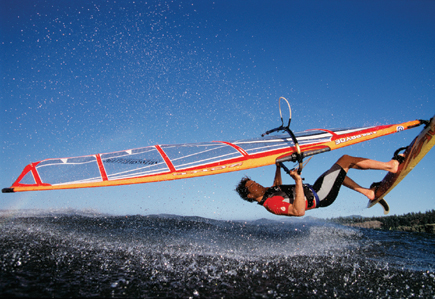Back It Up! How Four Pros Preserve And Protect Their Digital Images…And Why One Won’t Play That Game
Depending on which metaphor you like best, it's either the 800-pound
gorilla in the pixel palace or the fly in the digital ointment. It's also,
according to professional photographer Mark Gamba, "the thing no one is
talking about."
So let's talk about it.
It's the protection and storage issue.
Now, it's not likely you'll have as many photographs to care for
as the average pro has, and the pictures you have may not be your source of
income. But your photographs are important to you, and you want them to be safe
and secure for a long, long time.
Mark Gamba is a sports and adventure photographer who numbers National Geographic,
Adidas, UPS, and a host of sports gear manufacturers among his clients, and
it was a conversation with him nearly a year ago that sparked this article.
Mark told me he was still shooting film and had no plans to go digital, and
I wondered why. He had two major reasons: equipment issues and the fact that
his clients care about what he delivers, not what he shoots with. Fair enough,
I thought. But his third reason was a surprise: "When I shoot transparency,
I store the stuff as well as I know how--in a dark room, reasonable humidity,
in plastic pages designed not to affect the film, all that stuff. It isn't
that big of a deal; no huge hoops to jump through. And those images will still
be here, presumably 100 years from now. More important, 25 years from now when
someone calls up and says, `Hey, we want to use that shot of yours of
the diver and the whale shark,' because whale sharks are now extinct,
I'll have it. It won't matter if I've had a major computer
meltdown--and computer meltdowns are not something that could happen, they're
something that will happen."
 |
|
|
When Mark looks at digital he sees "extraordinary measures" of
necessary protection: "Duplicate copies of duplicate copies, and that's
just talking about one image. It takes a certain amount of continuous effort.
Somebody at some point every year or so has to think about that image and how
to protect it. Now multiply that times 500,000 images and you're talking
about thousands of terabytes of storage--storage that has to be backed
up in-house, because when you have to access an image, you have to access it
now. But it also has to be backed up out of house and preferably out of state,
so if something bad happens, like an electromagnetic pulse, or flood, or fire,
or tornado, it'll be safe. Of course those disasters can affect transparencies
as well, but having your photos in digital form adds more disasters to the list."
There's more. Beyond back-up efforts and location safety, there's
the question of media. For slides and negs we have temperature- and humidity-controlled
rooms and acid- and PVC-free plastic sleeves and pages. What've we got
for pixels?
"DVD is the current tangible storage device," Mark says. "Well,
the industry standard for the archival nature of a DVD is only said to be 10
years. So what happens when I get a call 25 years from now for that whale shark
picture?" Well, to be absolutely sure it would be accessible, Mark would
have had to have it recopied to new DVDs 21¼2 times. "And having
it on two or three DVDs doesn't guarantee any of them will play,"
he says, "or that there will be an available player, or that it will connect
to any computer of 2032."
Now, Mark admits that perhaps his images aren't that historically important,
but, he says, "there are guys out there who are shooting images that are.
Journalists are shooting digital, and 50 years from now there may not be a copy
of any of their images. Photography should be, and has been for the last century,
a medium of historic value, and it should continue to be so."
I began to wonder what other photographers were thinking and doing about backup
and storage. And so...
Doubling Up
"I think of myself as two photographers," Rob Van Petten says.
"First, the studio photographer who does limited-production, high-quality,
glossy, smart, stylish one-off images for national advertising campaigns. Those
kinds of jobs don't manufacture tons of digital data, so I archive them
on my own in a system that consists of a couple of external FireWire 80-gig
hard drives. I run a chronological database and have a logging system by date.
 |
|
|
"After a time, when that job is inert--done, printed, and been
on the drives three months--I'll burn selected files from the job
to DVDs. The files include a folder of a dozen of my favorite final images,
which I might use for stock or editorial promotion. They are usually raw files
and my PSDs [Photoshop Documents] with all the layers, and the final TIFFs and
perhaps other versions. I also sometimes include a lighting diagram. One of
the DVDs goes in my office, the other in my safe deposit box."
And that "other" photographer? "For my other jobs--stock
business, mainly--I use the Microsoft iView MediaPro file management system.
It's good for high volume archiving. What I've been doing recently
is purchasing a separate external drive for each significant, sizable job. One
goes to the client, the other's for me. I'll eventually burn the
images to DVDs and dump them off my drive. Meantime, there's a designated
drive for each job."
What about the future and new types of drives and new connections to computers?
First, Rob says, he takes his cues from "the smart people at the Center
for Digital Imaging at Boston University" for information and training.
Second, he knows there's gonna be a whole lotta transfer going on. "There's
no other way, no other choice," Rob says. "That's the cost,
in time and dollars, of doing business, of keeping our images safe."
Road Warrior
National Geographic photographer in residence Annie Griffiths Belt laughed when
I asked her about backing up images while on assignment. "Photographers
out in the field are way too paranoid about it, hauling back-up drives and laptops
and disk burners all over the place. I'm not into all that."
I wasn't surprised. Annie is known for traveling light. "Everything
has to fit in carryon," is her first rule of the road, and backing up
hasn't changed her approach. "I've tried a bunch of different
stuff," she says, "and I finally settled on a whole bunch of 16-gig
[memory] cards. And I never overwrite a card. I have an Epson P-4000, a digital
wallet, and I download onto that. And that's it. I tried one of those
portable DVD burners, but it took forever! I know, in theory the card and the
digital wallet could be struck by lightning and everything dies, but I traveled
for years hand-carrying exposed film, so when I hear about all these elaborate
back-up schemes, I just go, c'mon you guys! I know people who are traveling
with two laptops, three external hard drives, and a DVD burner!"
 |
|
|
Besides, to Annie the problem isn't backup. "I've found
the biggest risk to everything is airlines," she says, and her simple
solution to avoiding the separation blues--Annie goes to Zimbabwe, her
checked bag goes to Hackensack--is to never let the airline take anything
away from her. "I can do a two-week assignment with a carryon."
Back home, she downloads her cards onto the computer, then copies files onto
three dedicated external hard drives, then writes a DVD that's stored
in another location. Once a story is published, the only images she stores are
edits from the entire take.
"I'm not into that whole long-term `precious image'
thing," Annie says.
"I just don't think I'm that important. Nobody is going to
be going, `Oh my God, it's an Annie Griffiths Belt!'"
- Log in or register to post comments

































